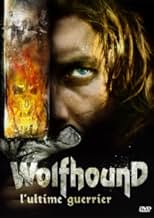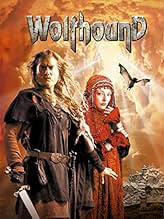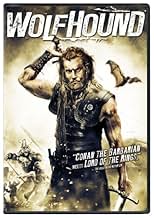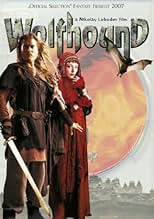VALUTAZIONE IMDb
5,6/10
4294
LA TUA VALUTAZIONE
Condannato a morire, è riuscito a sopravvivere e ora la sua missione è vendicare l'annientamento della sua tribù.Condannato a morire, è riuscito a sopravvivere e ora la sua missione è vendicare l'annientamento della sua tribù.Condannato a morire, è riuscito a sopravvivere e ora la sua missione è vendicare l'annientamento della sua tribù.
- Premi
- 2 vittorie e 9 candidature totali
Eugenia Tudorascu
- Khaygal
- (as Evgeniya Todorashko)
Juozas Budraitis
- Dungorm
- (as Yuozas Budraytis)
Trama
Lo sapevi?
- QuizSecond place big budget for any post-Soviet Russian film.
- ConnessioniEdited into Gothic: Der geheimnisvolle Händler (2012)
- Colonne sonoreWolfhound - Slaves Song (OST version)
Recensione in evidenza
Russia's first proper foray into Tolkeinesque fantasy cinema, WOLFHOUND, based on the first novel of a tetralogy by Maria Semyonova about a last-of-his-tribe mighty warrior, is a mixed bag on the one hand, it is formulaic, derivative and uneven in terms of acting and pacing; on the other, there is enough novelty in the film's distinctly Slavic demeanor, philosophical subtext and production design to make it play well internationally as a crossover curio.
WOLFHOUND opens with the back-story of the main character, a mighty warrior from the Grey Hound tribe named Wolfhound (Bukharov). While still only a child, Wolfhound's family is killed by marauders led by the evil priest Zhadoba and his henchman the Man-Eater (Domogarov). Zhadoba steals a sword forged by Wolfhound's father and has Wolfhound enslaved. The boy grows up dreaming of revenge.
Zhadoba is priest of Morana, a malevolent goddess that has been imprisoned by spell cast by the rulers of Galirad, one of whom, Princess Helen (Akinshina) is betrothed to the Man-Eater's son Vinitar (Bely) in an effort to keep the peace. Zhadoba is trying to free Morana to wreak havoc upon the world and subsequently dominate. He hopes to accomplish this by spilling the blood of Helen at the ancient shrine where Morana is imprisoned. Standing between him and his goal is Wolfhound, who, after saving Helen from an assassination attempt in Galirad, becomes her bodyguard.
Contrary to many Russians' fatalistic attitudes towards life, the film presents a new and intriguing philosophical slant in terms of the free will versus determinism debate, which comes out in favor of free will. Wolfhound frees himself from slavery by killing one of his captors, thereby changing his fate. As a free man, he pursues revenge, but throughout the film, his conscience, in the form of visions of a female spirit, comes to question whether the seemingly fated cycle of killing is worth continuing when he encounters Vinitar, the last of his enemies, in battle.
If the plot sounds formulaic and derivative, it is. Intentionally or not, the opening sequence is virtually a remake of John Milius's CONAN THE BARBARIAN. Masked in a sharp-toothed skull helmet, Zhadoba is vaguely reminiscent of Tolkein's dark lord Sauron. The predictability of the storyline and the pace, which lags in places, sometimes makes you wish they'd just get on with it. In terms of editing, the film could have been better served with a classic, chronological progression of the main character's life rather than its more trendy, non-linear, flashback tack, which dampens its philosophical message.
The performances are uneven, with the supporting cast generally better than the leads. TV heartthrob Bukharov (Russian TV series MAROSEIKA 12) and internationally known Oksana Akinshina (LILJA4EVER, THE BOURNE SUPREMACY) look appropriately wide-eyed in the right places, neither of them leaves much of an impression. The purported love story between them feels pat due to being underdeveloped plot-wise. Since this is Russia's first LOTR-style fantasy and the genre is very alien to Russian cinema, some sequences feel downright awkward in terms of acting. Also a bit gawky is the very noticeable use of facial close-ups, presumably in order for the film to subsequently play well on the small screen.
One of the more memorable performances was that of the matronly Nina Usatova as the leader of the savage Kharyuk people, whose lands Helen's entourage has to cross to reach her betrothed. Usatova steals every scene in that sequence, which is somewhat obviously played for comic relief.
Nevertheless, the film acquits itself well by stretching its comparatively shoestring budget to the limit. It looks similar to a $40 $50 million Hollywood film. The cinematography is atmospheric, well lit and generally melds well with the computer-generated effects. CGI use is rather sparing compared with something like LOTR, but then this is not only because of budgetary constraints. The filmmakers didn't cut corners on things like extras and sets. The film features around 1800 costumed extras, and nine different "large" sets were built, the most spectacular of these being Galirad, which covered 5 kilometers square on a Mosfilm studio backlot. The film also makes use of numerous on-location forest sequences shot in Slovakia. CGI is used mostly in the background in establishing shots and the level of CGI use builds up slowly, until going full-bore in the closing magical battle sequence. The battle scenes of are varying quality some are quite clear and easy to follow, while others are pretty sloppy and a blur of swords and grunts. The fighting is not very gory and would probably earn the film a PG-13 rating in the U.S.
The film's unique and exotic look, which draws on an amalgam of some never-before-seen elements from Slavic archeology, makes it a novelty item. Wolfhound looks positively Scythian with his long hair, beard, scars and animal-hide costume. Helen's red beaded wedding dress was painstakingly created from 3000 individual parts. The bat sidekick is a first, and its CGI is very accomplished nearly impossible to tell that the bat was not real. A healing process used by a white wizard to remedy some near-fatal wounds is also thus far one-of-kind. It uses heat provided from the campfires and the three healing sequences (one of them repairing the bat's wing) elicit a sense of wonder.
Outside of Russia, the film should benefit from the post-Lord-of-the-Rings renewed interest in the fantasy genre and the general curiosity about Russians' take on the genre.
WOLFHOUND opens with the back-story of the main character, a mighty warrior from the Grey Hound tribe named Wolfhound (Bukharov). While still only a child, Wolfhound's family is killed by marauders led by the evil priest Zhadoba and his henchman the Man-Eater (Domogarov). Zhadoba steals a sword forged by Wolfhound's father and has Wolfhound enslaved. The boy grows up dreaming of revenge.
Zhadoba is priest of Morana, a malevolent goddess that has been imprisoned by spell cast by the rulers of Galirad, one of whom, Princess Helen (Akinshina) is betrothed to the Man-Eater's son Vinitar (Bely) in an effort to keep the peace. Zhadoba is trying to free Morana to wreak havoc upon the world and subsequently dominate. He hopes to accomplish this by spilling the blood of Helen at the ancient shrine where Morana is imprisoned. Standing between him and his goal is Wolfhound, who, after saving Helen from an assassination attempt in Galirad, becomes her bodyguard.
Contrary to many Russians' fatalistic attitudes towards life, the film presents a new and intriguing philosophical slant in terms of the free will versus determinism debate, which comes out in favor of free will. Wolfhound frees himself from slavery by killing one of his captors, thereby changing his fate. As a free man, he pursues revenge, but throughout the film, his conscience, in the form of visions of a female spirit, comes to question whether the seemingly fated cycle of killing is worth continuing when he encounters Vinitar, the last of his enemies, in battle.
If the plot sounds formulaic and derivative, it is. Intentionally or not, the opening sequence is virtually a remake of John Milius's CONAN THE BARBARIAN. Masked in a sharp-toothed skull helmet, Zhadoba is vaguely reminiscent of Tolkein's dark lord Sauron. The predictability of the storyline and the pace, which lags in places, sometimes makes you wish they'd just get on with it. In terms of editing, the film could have been better served with a classic, chronological progression of the main character's life rather than its more trendy, non-linear, flashback tack, which dampens its philosophical message.
The performances are uneven, with the supporting cast generally better than the leads. TV heartthrob Bukharov (Russian TV series MAROSEIKA 12) and internationally known Oksana Akinshina (LILJA4EVER, THE BOURNE SUPREMACY) look appropriately wide-eyed in the right places, neither of them leaves much of an impression. The purported love story between them feels pat due to being underdeveloped plot-wise. Since this is Russia's first LOTR-style fantasy and the genre is very alien to Russian cinema, some sequences feel downright awkward in terms of acting. Also a bit gawky is the very noticeable use of facial close-ups, presumably in order for the film to subsequently play well on the small screen.
One of the more memorable performances was that of the matronly Nina Usatova as the leader of the savage Kharyuk people, whose lands Helen's entourage has to cross to reach her betrothed. Usatova steals every scene in that sequence, which is somewhat obviously played for comic relief.
Nevertheless, the film acquits itself well by stretching its comparatively shoestring budget to the limit. It looks similar to a $40 $50 million Hollywood film. The cinematography is atmospheric, well lit and generally melds well with the computer-generated effects. CGI use is rather sparing compared with something like LOTR, but then this is not only because of budgetary constraints. The filmmakers didn't cut corners on things like extras and sets. The film features around 1800 costumed extras, and nine different "large" sets were built, the most spectacular of these being Galirad, which covered 5 kilometers square on a Mosfilm studio backlot. The film also makes use of numerous on-location forest sequences shot in Slovakia. CGI is used mostly in the background in establishing shots and the level of CGI use builds up slowly, until going full-bore in the closing magical battle sequence. The battle scenes of are varying quality some are quite clear and easy to follow, while others are pretty sloppy and a blur of swords and grunts. The fighting is not very gory and would probably earn the film a PG-13 rating in the U.S.
The film's unique and exotic look, which draws on an amalgam of some never-before-seen elements from Slavic archeology, makes it a novelty item. Wolfhound looks positively Scythian with his long hair, beard, scars and animal-hide costume. Helen's red beaded wedding dress was painstakingly created from 3000 individual parts. The bat sidekick is a first, and its CGI is very accomplished nearly impossible to tell that the bat was not real. A healing process used by a white wizard to remedy some near-fatal wounds is also thus far one-of-kind. It uses heat provided from the campfires and the three healing sequences (one of them repairing the bat's wing) elicit a sense of wonder.
Outside of Russia, the film should benefit from the post-Lord-of-the-Rings renewed interest in the fantasy genre and the general curiosity about Russians' take on the genre.
I più visti
Accedi per valutare e creare un elenco di titoli salvati per ottenere consigli personalizzati
- How long is Wolfhound?Powered by Alexa
Dettagli
- Data di uscita
- Paese di origine
- Siti ufficiali
- Lingua
- Celebre anche come
- Wolfhound from the Tribe of Grey Dogs
- Luoghi delle riprese
- Azienda produttrice
- Vedi altri crediti dell’azienda su IMDbPro
Botteghino
- Budget
- 20.000.000 USD (previsto)
- Lordo in tutto il mondo
- 21.573.338 USD
- Tempo di esecuzione2 ore 22 minuti
- Colore
- Mix di suoni
- Proporzioni
- 2.35 : 1
Contribuisci a questa pagina
Suggerisci una modifica o aggiungi i contenuti mancanti






































